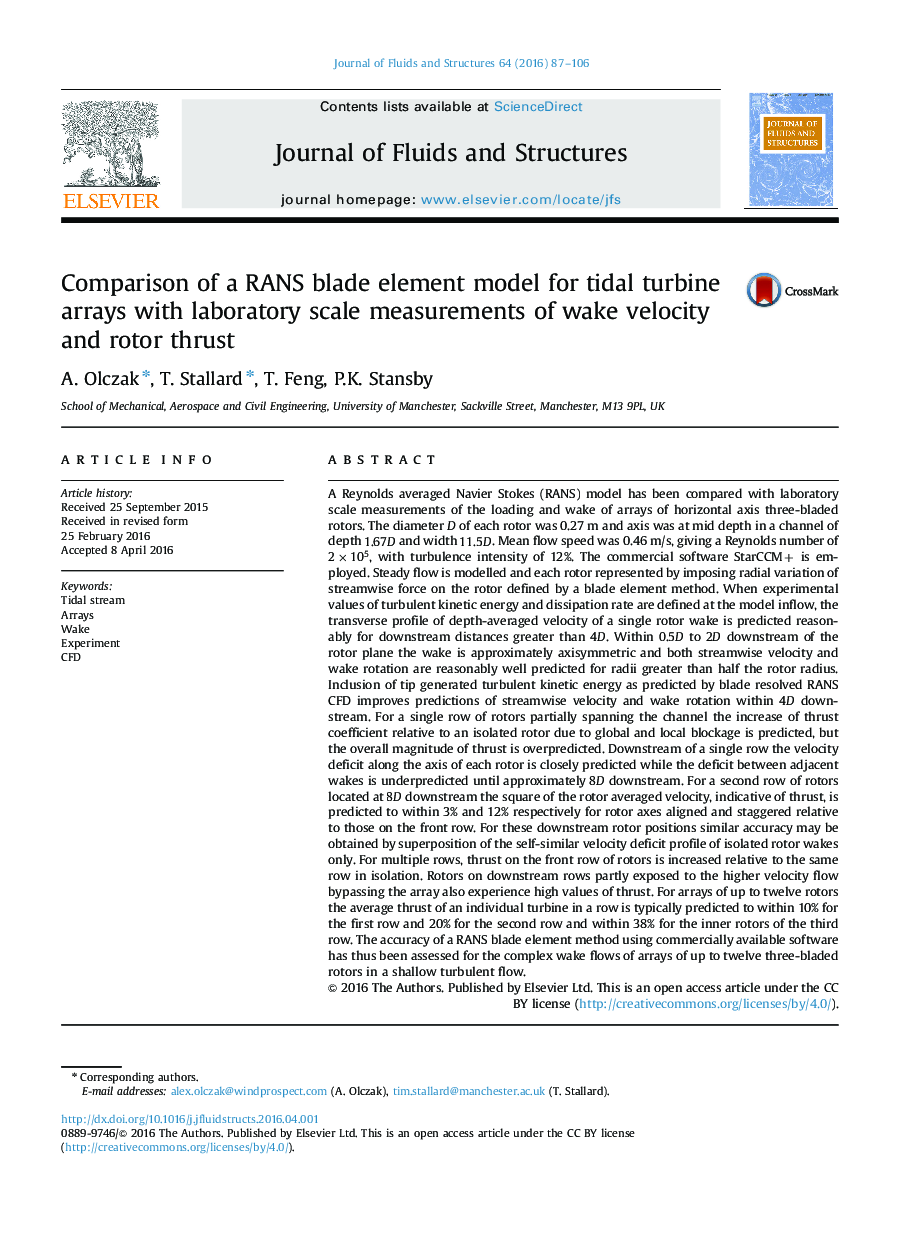| کد مقاله | کد نشریه | سال انتشار | مقاله انگلیسی | نسخه تمام متن |
|---|---|---|---|---|
| 7175897 | 1466583 | 2016 | 20 صفحه PDF | دانلود رایگان |
عنوان انگلیسی مقاله ISI
Comparison of a RANS blade element model for tidal turbine arrays with laboratory scale measurements of wake velocity and rotor thrust
دانلود مقاله + سفارش ترجمه
دانلود مقاله ISI انگلیسی
رایگان برای ایرانیان
کلمات کلیدی
موضوعات مرتبط
مهندسی و علوم پایه
سایر رشته های مهندسی
مهندسی مکانیک
پیش نمایش صفحه اول مقاله

چکیده انگلیسی
A Reynolds averaged Navier Stokes (RANS) model has been compared with laboratory scale measurements of the loading and wake of arrays of horizontal axis three-bladed rotors. The diameter D of each rotor was 0.27Â m and axis was at mid depth in a channel of depth 1.67D and width 11.5D. Mean flow speed was 0.46Â m/s, giving a Reynolds number of 2Ã105, with turbulence intensity of 12%. The commercial software StarCCM+ is employed. Steady flow is modelled and each rotor represented by imposing radial variation of streamwise force on the rotor defined by a blade element method. When experimental values of turbulent kinetic energy and dissipation rate are defined at the model inflow, the transverse profile of depth-averaged velocity of a single rotor wake is predicted reasonably for downstream distances greater than 4D. Within 0.5D to 2D downstream of the rotor plane the wake is approximately axisymmetric and both streamwise velocity and wake rotation are reasonably well predicted for radii greater than half the rotor radius. Inclusion of tip generated turbulent kinetic energy as predicted by blade resolved RANS CFD improves predictions of streamwise velocity and wake rotation within 4D downstream. For a single row of rotors partially spanning the channel the increase of thrust coefficient relative to an isolated rotor due to global and local blockage is predicted, but the overall magnitude of thrust is overpredicted. Downstream of a single row the velocity deficit along the axis of each rotor is closely predicted while the deficit between adjacent wakes is underpredicted until approximately 8D downstream. For a second row of rotors located at 8D downstream the square of the rotor averaged velocity, indicative of thrust, is predicted to within 3% and 12% respectively for rotor axes aligned and staggered relative to those on the front row. For these downstream rotor positions similar accuracy may be obtained by superposition of the self-similar velocity deficit profile of isolated rotor wakes only. For multiple rows, thrust on the front row of rotors is increased relative to the same row in isolation. Rotors on downstream rows partly exposed to the higher velocity flow bypassing the array also experience high values of thrust. For arrays of up to twelve rotors the average thrust of an individual turbine in a row is typically predicted to within 10% for the first row and 20% for the second row and within 38% for the inner rotors of the third row. The accuracy of a RANS blade element method using commercially available software has thus been assessed for the complex wake flows of arrays of up to twelve three-bladed rotors in a shallow turbulent flow.
ناشر
Database: Elsevier - ScienceDirect (ساینس دایرکت)
Journal: Journal of Fluids and Structures - Volume 64, July 2016, Pages 87-106
Journal: Journal of Fluids and Structures - Volume 64, July 2016, Pages 87-106
نویسندگان
A. Olczak, T. Stallard, T. Feng, P.K. Stansby,